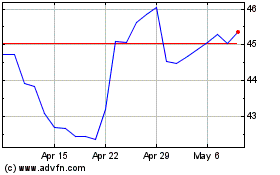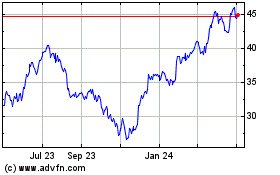Fed Approves Ally Financial's Capital Plan
June 29 2016 - 4:59PM
Dow Jones News
By Rachel Louise Ensign
The U.S. Federal Reserve approved Ally Financial Inc.'s capital
plan in the regulator's annual stress test released Wednesday.
Ally had previously said it included a common-stock dividend in
its capital plan, indicating that the Fed's approval would likely
clear the way for Ally to pay its first such dividend since going
public in 2014. The payout would be a milestone in the firm's long
road to regaining financial health after getting a government
bailout during the financial crisis. Ally's CEO has also said the
bank requested permission for buybacks.
Ally, spun off from General Motors Co. in 2006 and formerly
known as GMAC, is among the largest U.S. auto lenders. In its
current form, the bank has branched out into other services like
online banking.
Ally's plan was approved after the Fed found that the bank could
keep lending in a severe economic downturn. The approval clears the
way for the firm to reward investors by returning capital either
through dividend payouts, by buying back stock or both.
At the low point of a hypothetical recession, Ally's common
equity Tier 1 ratio -- which measures high-quality capital as a
share of risk-weighted assets -- would be 5.2%, above the 4.5%
level the Fed views as a minimum. The new ratio, unlike the one
reported last week by the Fed in a related test, takes into account
the bank's proposed capital plan.
Ally's Tier 1 leverage ratio, which measures high-quality
capital as a share of all assets, would have reached as low as 5.9%
in a hypothetical recession, above the 4% Fed minimum.
The latest stress-test result incorporates quantitative factors
assessed in data released by the Fed last week. These included a
simulation of how the bank's capital buffers would hold up under a
world-wide recession. The Fed's "severely adverse" scenario of
financial stress this year included a 10% U.S. unemployment rate,
significant losses in corporate and commercial real estate lending
portfolios, and negative rates on short-term U.S. Treasury
securities.
This second-part of the test also included a qualitative
assessment by the Fed of a bank's capital-planning process and
internal controls. The Fed has the ability to object to a bank's
capital plan on either quantitative or qualitative grounds.
The Fed's Wednesday results are arguably the more important part
of the stress-test process since it dictates how much capital will
be returned to shareholders. Increased dividends and buybacks can
help to bolster a bank's share price.
Write to Rachel Louise Ensign at rachel.ensign@wsj.com
(END) Dow Jones Newswires
June 29, 2016 16:44 ET (20:44 GMT)
Copyright (c) 2016 Dow Jones & Company, Inc.
General Motors (NYSE:GM)
Historical Stock Chart
From Mar 2024 to Apr 2024

General Motors (NYSE:GM)
Historical Stock Chart
From Apr 2023 to Apr 2024
